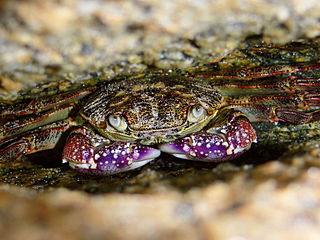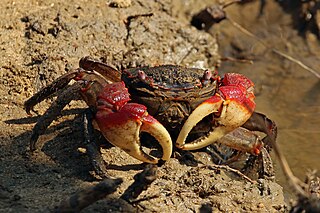
The Diogenidae are a family of hermit crabs, sometimes known as "left-handed hermit crabs" because in contrast to most other hermit crabs, its left chela (claw) is enlarged instead of the right. It comprises 429 extant species, and a further 46 extinct species, making it the second-largest family of marine hermit crabs, after the Paguridae.

Majidae is a family of crabs, comprising around 200 marine species inside 52 genera, with a carapace that is longer than it is broad, and which forms a point at the front. The legs can be very long in some species, leading to the name "spider crab". The exoskeleton is covered with bristles to which the crab attaches algae and other items to act as camouflage.

Leptograpsus variegatus, known as the purple rock crab, is a marine large-eyed crab of the family Grapsidae, found in southern subtropical Indo-Pacific Oceans. It grows to around 50 millimetres (2.0 in) shell width. It is the only species in the genus Leptograpsus.

The Grapsoidea are a superfamily of crabs; they are well known and contain many taxa which are terrestrial (land-living), semiterrestrial, or limnic. Another well-known member with a more conventional lifestyle is the Chinese mitten crab, Eriocheir sinensis.

The Gecarcinucidae are a family of true freshwater crabs. They are found throughout South Asia, Southeast Asia and New Guinea, with a single genus found in Australia.

Calappidae is a family of crabs containing 16 genera, of which 7 are only known as fossils:

The Sesarmidae are a family of crabs, previously included in the Grapsidae by many authors. Several species, namely in Geosesarma, Metopaulias, and Sesarma, are true terrestrial crabs. They do not need to return to the sea even for breeding.

The Varunidae are a family of thoracotrematan crabs. The delimitation of this family, part of the taxonomically confusing Grapsoidea, is undergoing revision. For a long time, they were placed at the rank of subfamily in the Grapsidae, but they appear to be closest to Macropthalmus and the Mictyridae, which are usually placed in the Ocypodoidea. It may thus be better to merge the latter superfamily with the Grapsoidea, retaining the latter name as it is older.
Etyiidae is a prehistoric family of dromiacean crabs only known from Cretaceous and a few Paleocene fossils.

Goneplacidae is a family of crabs of the order Decapoda and the superfamily Goneplacoidea. It includes the following genera:

Pilumnoidea is a superfamily of crabs, whose members were previously included in the Xanthoidea. The three families are unified by the free articulation of all the segments of the male crab's abdomen and by the form of the gonopods. The earliest fossils assigned to this group are of Eocene age.

Percnon gibbesi is a species of crab. It is one of at least two species commonly called Sally Lightfoot, and is also referred to as the nimble spray crab or urchin crab. It has been described as "the most invasive decapod species to enter the Mediterranean".

Actumnus is a genus of crabs in the family Pilumnidae. Alongside the 28 extant species, it has a fossil record extending back into the Miocene.

Trichodactylidae is a family of crabs, in its own superfamily, Trichodactyloidea. They are all freshwater animals from Central and South America, including some offshore islands, such as Ilhabela, São Paulo. Only one of the 50 species is known from the fossil record, Sylviocarcinus piriformis from the Miocene of Colombia. The family contains 15 genera in two subfamilies:

Hepatus is a genus of crabs in the family Aethridae, containing seven extant species, plus some fossil species:

Geograpsus is a genus of crabs in the family Grapsidae, containing four extant species, and one extinct species:

Atergatis is a genus of crabs in the family Xanthidae, containing the following species:

Cyclograpsus is a genus of crabs, containing the following species:

Armases is a genus of true crabs in the family Sesarmidae. There are about 13 described species in Armases.

















